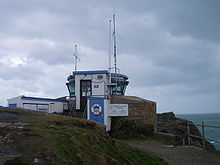National Coastwatch Institution
The National Coastwatch Institution (Engl., About national coastal surveillance organization ), short NCI , is a British organization of independent welfare . It has set itself the goal of visually monitoring the British ocean coast in order to be able to identify emergencies at sea in good time.
The organization is not to be confused with the HM Coastguard , the official coastguard of Great Britain, or the Royal National Lifeboat Institution , the sea rescue organization. However, the three organizations work closely together and share the task of saving lives at sea and on the coast. Together they are subject to the regulations of the Maritime and Coastguard Agency (Ministry of Maritime Affairs).
history
Until the 1990s, the British Coast Guard had manned various lookout posts on the coast. The service was seen as out of date and too expensive and therefore officially abandoned. Marine radio and radar made visual surveillance of the coast seem superfluous.
In 1994 two fishermen lost their lives off the coast of Cornwall , in the immediate vicinity of the British Coast Guard's recently closed Bass Point coast guard. This led to the creation of the NCI. First, the abandoned coast station at Bass Point by the HM Coastguard was renovated and manned again in November 1994. As a result, other posts quickly opened in Devon , Cornwall, East Anglia , Somerset , Sussex , Essex , Dorset and South Wales . Mostly abandoned coastal buildings of the coast guard, old lighthouses or similar buildings were rented or bought, which are also designed to withstand severe weather on the coast.
Today there are 50 NCI stations across England and Wales, manned by over 2000 volunteers. Other possible locations are being evaluated. There are currently no stations in Scotland or Northern Ireland, although similar organizations have been founded there.
Equipment and work
Currently (2014) the organization has more than 2000 volunteers who occupy the 50 stations of the NCI during the day. The stations are equipped with modern equipment such as marine radios and radar . However, binoculars with which the sea and the coast can be monitored are central . Smaller boats, surfers or divers in particular are not equipped with radios to be able to call Mayday in an emergency . Parachute missiles and other optical distress signals can only set the rescue chain in motion if they are seen.
In addition to shipping, the adjacent coast is also monitored, because it happens again and again that people under the cliffs of the southern English coast are in need because the tide cuts them off or someone is washed out with an air mattress on the open sea.
Every post and its employees are subject to strict controls to ensure their readiness for action. The training for the volunteers includes marine radio, radar, map reading and the right behavior in emergencies.
The organization is financed through donations. The voluntary “guards” do not receive any wages and pay for their own travel and uniforms. The professional equipment of the stations and their complete renovation, which is often necessary when taking over, still costs a lot of money.

